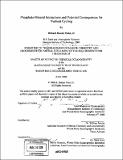Phosphate-mineral interactions and potential consequences for nutrient cycling
Author(s)
Oates, Richard Hunter
DownloadFull printable version (12.94Mb)
Other Contributors
Woods Hole Oceanographic Institution.
Advisor
William Martin.
Terms of use
Metadata
Show full item recordAbstract
Biogeochemical cycling of phosphate is a key component in the overall production rate of coastal ecosystems. Mineral phases in the near-shore sediments play a significant role in the return of phosphate remineralized in the upper sediments to the water column. Sequential Extraction (SEDEX) of the solid-phase associated P04-3 yielded reservoir profiles of phosphate at three sites off of the Massachusetts coast. These extractions found Fe-associated P04 to be the dominant phase associated with rapid porewater-solid P exchange. Additionally, a seasonal enrichment/depletion pattern of phosphate fluxes relative to total carbon was observed from the sediments. These observations established the behavior of phosphate in coastal sediments as interconnected with the ongoing Fe-cycling in the sediments as well.
Description
Thesis (S.M.)--Joint Program in Oceanography (Massachusetts Institute of Technology, Dept. of Earth, Atmospheric, and Planetary Sciences; and the Woods Hole Oceanographic Institution), 2008. Includes bibliographical references (p. 45-47).
Date issued
2008Department
Joint Program in Oceanography; Woods Hole Oceanographic Institution; Massachusetts Institute of Technology. Department of Earth, Atmospheric, and Planetary SciencesPublisher
Massachusetts Institute of Technology
Keywords
Joint Program in Oceanography., Earth, Atmospheric, and Planetary Sciences., Woods Hole Oceanographic Institution.